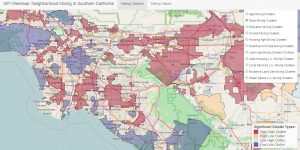Publication:
Hipp, John R., Kevin Kane, and Jae Hong Kim. (2017). “Recipes for Neighborhood Development: A Machine Learning Approach toward Understanding the Impact of Mixing in Neighborhoods.” Landscape and Urban Planning.
Abstract:
Scholars of New Urbanism have suggested that mixing along various dimensions in neighborhoods (e.g., income, race/ethnicity, land use) may have positive consequences for neighborhoods, particularly for economic dynamism. A challenge for empirically assessing this hypothesis is that the impact of mixing may depend on various socio-demographic characteristics of the neighborhood and takes place in a complex fashion that cannot be appropriately handled by traditional statistical analytical approaches. We utilize a rarely used, innovative estimation technique—kernel regularized least squares—that allows for nonparametric estimation of the relationship between various neighborhood characteristics in 2000 and the change in average household income in the neighborhood from 2000 to 2010. The results demonstrate that the relationships between average income growth and both income mixing and racial/ethnic mixing are contingent upon several neighborhood socio-demographic “ingredients”. For example, racial mixing is positively associated with average income over time when it occurs in neighborhoods with a high percentage of Latinos or immigrants, high population density, or high housing age mixing. Income mixing is associated with worsening average household income in neighborhoods with more poverty, unemployment, immigrants, or population density. It appears that considering the broader characteristics of the neighborhood is important for understanding economic dynamism.
